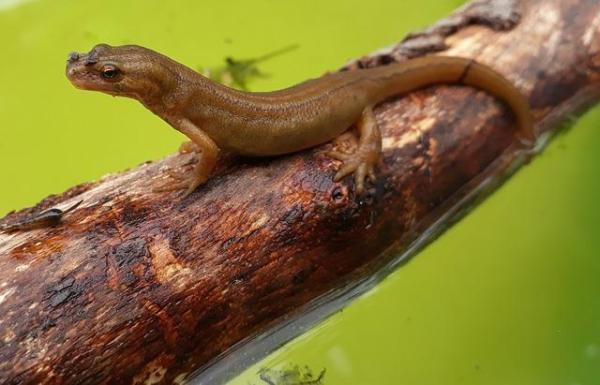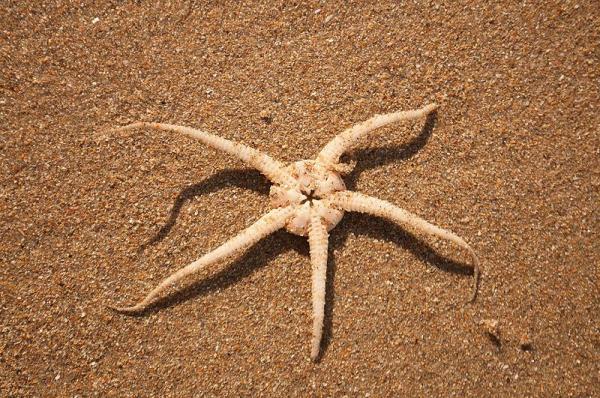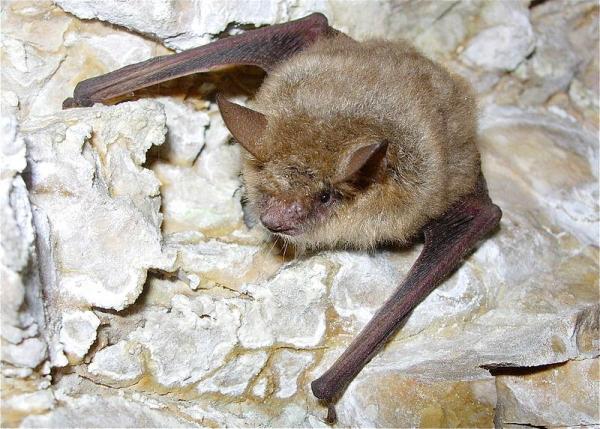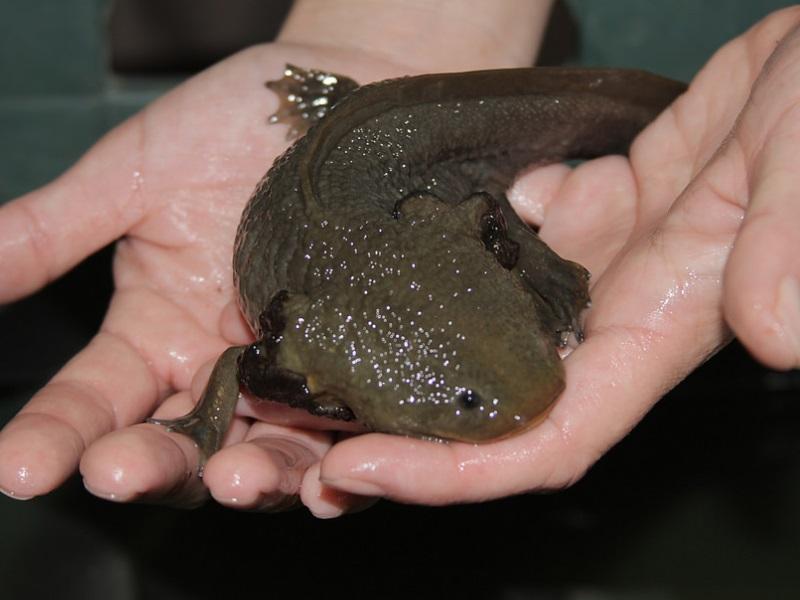Animals That Breathe Through Their Skin


Respiration is the process by which living things take in oxygen from the air or water and release carbon dioxide, and is essential for all life functions. There are different types of respiratory systems: Cutaneous respiration, gill respiration, tracheal respiration, and pulmonary respiration. In cutaneous respiration, the skin itself is the respiratory surface rather than gills or lungs. The process of cutaneous respiration is found in a variety of organisms, including insects, amphibians, fish, sea snakes, turtles, and to a lesser extent, mammals.
In this article from thedailyECO we explain what cutaneous respiration is and introduce you to 16 animals that breathe through their skin.
What is cutaneous respiration or skin breathing?
Cutaneous respiration, also known as cutaneous gas exchange, is a type of respiration that occurs through the skin, rather than gills or lungs, in certain groups of animals. Almost all animals absorb traces of oxygen through their skin. However, there are a few animals that rely almost entirely on skin respiration to take in all or most of their oxygen. These organisms are usually small and have low metabolic activity because their respiratory capacity is low.
Skin respiration is not much different from other types of respiration. Whether air or water, the environment is filled with oxygen molecules. In fact, our body is constantly in contact with oxygen and other gas molecules. Although the skin appears to be solid, it is actually permeable, allowing molecules and substances to enter or leave the skin.
Through a process known as diffusion, oxygen enters the thin blood vessels near the surface of the skin, and then the oxygenated blood is carried throughout the body as in the lungs. The same is true for carbon dioxide, which is excreted from the body through the skin.
Most of these animals that breathe through the skin live in aquatic environments or very humid places, as it is only effective in these environments. In fact, for this type of breathing to be possible, the skin must not only be moist, but very thin so that oxygen and carbon dioxide can diffuse through it. To facilitate this process, the skin must also be well supplied with blood in its inner layers. Certain animals such as amphibians and soft-shelled turtles even have mucous glands that help keep the skin moist. Also, some amphibians have folds in their skin that increase their respiration rate.
Animals that use this type of respiration also have lungs or gills to allow respiratory exchange and supplement skin respiration. In fact, only salamanders survive solely by skin respiration.
In the following sections, we will give you some examples of animals that breathe through the skin.

Annelids that breathe through their skin
We begin this list with the annelids, also known as segmented worms. They are a large phylum with more than 22,000 existing species, including lobe worms, earthworms, and leeches. Gas exchange usually occurs through the skin in annelids, and the process is usually carried by a pigment called hemoglobin or chlorocruorin, which is responsible for transporting oxygen. However, it may also occur through the gill filaments in some polychaetes or through the rectum in aquatic oligochaetes.
Earthworm
This animal is found in tunnels in the soil, which it creates to feed. In this way, organic material enters its digestive system and is then excreted in the form of excrement. Through this process it softens the soil, enriches it and aerates it. Earthworms have no lungs, but breathe through their skin. Their skin must remain moist for dissolved oxygen to enter their bloodstream. The earthworm's skin is covered with mucus, and it must live in a moist environment.
Leech
This is an animal with an elongated body and suckers at both ends. Leeches feed on the blood they suck from their prey. They breathe through their skin, although there are species that have gills that resemble side branches on the body. In some species, oxygen is carried by a red pigment called hemoglobin, which carries up to half of the oxygen they need to survive.
Nereis (Perinereis)
Nereis is a marine worm with an elongated, semi-cylindrical body and ring-shaped segments. It has four eyes and strong jaws to catch its prey. Lacking specialized respiratory organs, it breathes through its body surface, mainly through thin, flat appendages on the sides of its body.

Amphibians that breathe through their skin
Amphibians are animals that have up to three forms of respiration, depending on their life stage and activity level. These are pulmonary respiration, respiration through the oral mucosa (mostly at rest), and cutaneous respiration (which is responsible for taking in 90% of the oxygen needed). Below are some examples of amphibians that breathe through the skin:
Axolotl
You may have heard that axolotls breathe in several ways, including through their lungs. In fact, axolotls are complex animals that develop lungs but, unlike other salamanders, stay in the water their entire lives and therefore do not use these lungs. Axolotls, like all other aquatic life, require oxygen and have developed a few interesting systems to oxygenate their blood.
Axolotls have thin and moist skin, through which gas can diffuse rapidly into the blood vessels closest to the skin and be carried by the blood to the cells. This diffusion occurs quickly and efficiently. The feathers that decorate the gills also have a function, they increase the surface area and allow a greater volume of gas to diffuse into the blood.
Frogs
Frogs are anuran amphibians that undergo metamorphosis from birth to the adult stage. Therefore, the way they breathe varies by life stage and season. During the aquatic tadpole stage, they breathe through their gills and skin, while in adulthood they use lung and skin respiration. In winter, they tend to use skin respiration because they are not as active and require less oxygen. In summer, on the other hand, they mainly use lung respiration because they are more active and therefore need more oxygen.
Toads
Toads are also anuran amphibians. They differ from frogs in size, leg length, skin roughness, and the way they move. However, toads have the same type of respiration as frogs, which is cutaneous in the larval and tadpole stages and primarily pulmonary in the adult stage, when their skin is less moist.
Newts
Newts are semiaquatic animals, meaning they live both on land and in water. In each of these unique environments, they have different ways of breathing. On land, they breathe with their lungs, but in water, they breathe through their skin. Underwater, newts breathe by taking in oxygen through their skin. This is possible because their skin contains thin membranes and a large network of blood vessels, through which oxygen dissolved in the water can diffuse directly into their bloodstream. However, their oxygen supply is usually insufficient, so after a limited time underwater they have to surface to breathe.
Caecilians
Caecilians are a group of limbless, worm-like or snake-like amphibians. They live mostly hidden in soil and river substrates, making them the least known order of amphibians. Some have rudimentary lungs, although their respiration is primarily cutaneous; other species have no lungs.
Continue reading this other article to learn more about the difference between frogs and toads.

Echinoderms that breathe through their skin
Echinoderms have a simple respiratory system. Depending on the species, they breathe through the skin or through simple gills or projections on the body, such as tube feet. Oxygen is then circulated through the organism by either system or a combination of both. Among the echinoderms with cutaneous respiration, we can mention:
Sea urchin
Although the sea urchin can obtain oxygen by simply standing still in water, the way it distributes oxygen throughout the body is unique. Instead of the respiratory system that many organisms use, urchin have a water vascular system that is used for respiration, among other things. A water vascular system is a network of channels that ends in the urchin's tubed feet.
Sea cucumber
It is an echinoderm with an elongated and soft body without limbs. Their size ranges from a few millimeters to several meters. All sea cucumber species breathe by dilating their anal sphincter to draw water into their rectum, where specialized structures called respiratory trees extract oxygen molecules from the water.
Ophiura or the brittle star
This is a starfish-like echinoderm with a rounded and flattened central structure from which protrude its long and slender arms, which it uses for locomotion. To breathe, they use bursae into which water enters and exits. The water flows through the bursae with the help of cilia or muscle contraction.

Reptiles and mammals that breathe through their skin
Some studies suggest that the rough, thick skin of reptiles does not allow them to breathe through the skin as amphibians do. For this reason, their breathing is primarily pulmonary. However, some species may use this kind of breathing under certain conditions. Some of these reptiles are:
- Sea snake or coral reef snake
- Musk turtle (Sternotherus odoratus)
- European green lizard (Lacerta viridis)
- Japanese pond turtle (Mauremys japonica)
On the other hand, most mammals cannot exchange oxygen and carbon dioxide through the skin because of their high metabolic rate and poor diffusion through the skin. However, there is one known exception to this rule, the Brazilian brown bat (Eptesicus brasiliensis), which gains about 15% of its oxygen and excretes 5% of its carbon dioxide in this way.
You may also be interested in this other article, where we talk about how insects breathe and what tracheal breathing is.

If you want to read similar articles to Animals That Breathe Through Their Skin, we recommend you visit our Facts about animals category.










